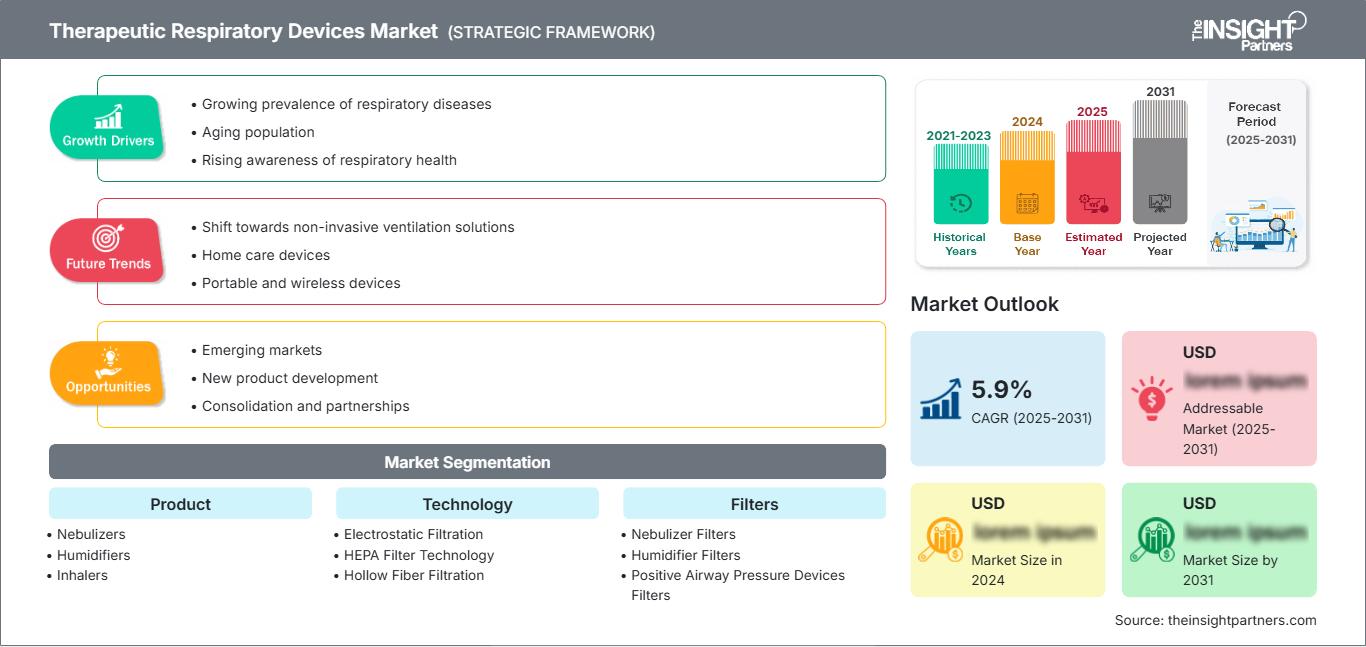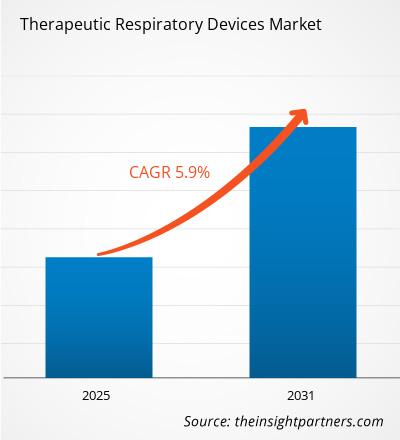Der Markt für therapeutische Beatmungsgeräte wird bis 2031 voraussichtlich ein Volumen von 47,44 Milliarden US-Dollar erreichen. Für den Zeitraum 2025–2031 wird ein jährliches Wachstum von 5,4 % erwartet.
Der Bericht ist segmentiert nach Produkt (Vernebler, Luftbefeuchter, Inhalatoren, Sauerstoffkonzentratoren, Geräte zur positiven Atemwegsdrucktherapie, Beatmungsgeräte, Kapnographen, Gasanalysegeräte und Sonstige), Technologie (elektrostatische Filtration, HEPA-Filtertechnologie, Hohlfaserfiltration und Mikrosphärenabscheidung) und Filtern (Verneblerfilter, Luftbefeuchterfilter, Filter für Geräte zur positiven Atemwegsdrucktherapie, Sauerstoffkonzentratorfilter und Beatmungsgerätefilter). Ziel des Berichts ist es, die aktuelle Marktsituation und das zukünftige Wachstum, die wichtigsten Triebkräfte, Herausforderungen und Chancen zu beschreiben. Dies wird verschiedenen Akteuren im Geschäftsbereich Einblicke ermöglichen, wie beispielsweise:
- Technologieanbieter/Hersteller: Um die sich entwickelnde Marktdynamik zu verstehen und potenzielle Wachstumschancen zu erkennen, können sie fundierte strategische Entscheidungen treffen.
- Investoren: Um eine umfassende Trendanalyse hinsichtlich Marktwachstumsrate, Finanzprognosen und Chancen entlang der Wertschöpfungskette durchzuführen.
- Regulierungsbehörden: Um Richtlinien zu regulieren und Aktivitäten auf dem Markt zu überwachen, mit dem Ziel, Missbrauch zu minimieren, das Vertrauen der Anleger zu wahren und die Integrität und Stabilität des Marktes zu gewährleisten.
Marktsegmentierung für therapeutische Atemgeräte Produkt
- Vernebler
- Befeuchter
- Inhalatoren
- Sauerstoffkonzentratoren
- Geräte zur positiven Atemwegsdrucktherapie
- Beatmungsgeräte
- Kapnographen
- Gasanalysatoren
- Sonstige
Technologie
- Elektrostatische Filtration
- HEPA-Filtertechnologie
- Hohlfaserfiltration
- Mikrosphärenabscheidung
Filter
- Verneblerfilter
- Befeuchterfilter
- Filter für Geräte zur positiven Atemwegsdrucktherapie
- Sauerstoffkonzentratorfilter
- Beatmungsgerätefilter
Geografie
- Nordamerika
- Europa
- Asien-Pazifik
- Süd- und Mittelamerika
- Naher Osten und Afrika
Sie erhalten kostenlos Anpassungen an jedem Bericht, einschließlich Teilen dieses Berichts oder einer Analyse auf Länderebene, eines Excel-Datenpakets sowie tolle Angebote und Rabatte für Start-ups und Universitäten.
Markt für therapeutische Beatmungsgeräte: Strategische Einblicke

-
Holen Sie sich die wichtigsten Markttrends aus diesem Bericht.Dieses KOSTENLOSE Beispiel umfasst Datenanalysen, die von Markttrends bis hin zu Schätzungen und Prognosen reichen.
Wachstumstreiber für den Markt für therapeutische Beatmungsgeräte
- Zunehmende Verbreitung von Atemwegserkrankungen:
- Die rapide Zunahme von Atemwegserkrankungen wie chronisch-obstruktiver Lungenerkrankung (COPD), chronischer Bronchitis und Asthma wird den Markt für therapeutische Beatmungsgeräte ankurbeln. Die Weltgesundheitsorganisation (WHO) berichtet, dass COPD jährlich für drei Millionen Todesfälle verantwortlich ist und damit die dritthäufigste Todesursache weltweit darstellt. Rund 65 Millionen Menschen leiden an dieser Krankheit. Die steigende Inzidenz von Atemwegserkrankungen dürfte diesen Markt weiter beflügeln.
- Alternde Bevölkerung:
- Ein weiterer wichtiger Wachstumstreiber für den Markt für therapeutische Beatmungsgeräte ist das Alter der Bevölkerung. Mit zunehmendem Alter steigt das Risiko für Lungenerkrankungen wie COPD, die letztendlich zu chronischem Atemversagen führen können. Es wird geschätzt, dass im Jahr 2050 fast 1,5 Milliarden Menschen 65 Jahre und älter sein werden und daher therapeutische Beatmungsgeräte zur besseren Behandlung chronischer Atemwegserkrankungen benötigen.
- Steigendes Bewusstsein für Atemwegsgesundheit:
- Das wachsende Bewusstsein der Bevölkerung für Atemwegsgesundheit treibt auch den Markt für therapeutische Beatmungsgeräte an. Das Bewusstsein für die Lungengesundheit und die Notwendigkeit der Früherkennung von Krankheiten fördert die Bereitschaft, frühzeitig ärztliche Hilfe in Anspruch zu nehmen, und steigert somit die Nachfrage nach therapeutischen Beatmungsgeräten. Dieses wachsende Bewusstsein fördert auch die Nutzung von Heimpflegegeräten und nicht-invasiven Beatmungslösungen, die einfachere und kostengünstigere Behandlungsmöglichkeiten bieten.
Zukünftige Trends auf dem Markt für therapeutische Beatmungsgeräte
- Verlagerung hin zu nicht-invasiven Beatmungslösungen:
- Der Trend zu NIV-Lösungen gewinnt auf dem Markt für therapeutische Beatmungsgeräte rasant an Fahrt. Dies liegt vor allem daran, dass die mit NIV verbundenen Komplikationen geringer sind; Es verbessert die Behandlungsergebnisse, verkürzt Krankenhausaufenthalte und kann eine Intubation weitestgehend vermeiden. Dies wird maßgeblich durch den technologischen Fortschritt, die zunehmende Anwendung nichtinvasiver Beatmungstherapie und das wachsende Bewusstsein für die Vorteile der NIV bei allen Gesundheitsdienstleistern und Patienten gefördert.
- Geräte für die Heimpflege:
- In den letzten Jahren hat sich ein weiterer Trend und ein wichtiges Thema auf dem Markt für therapeutische Beatmungsgeräte herauskristallisiert: Geräte für die Heimpflege. Dies ist vor allem auf das steigende Bewusstsein für eine wirtschaftliche und patientenorientierte Versorgung zurückzuführen. Dadurch ist die Nachfrage nach Heimpflegegeräten gestiegen, da Patienten die gesamte benötigte Behandlung zu Hause erhalten und Krankenhausaufenthalte sowie weitere Kosten vermeiden können, während gleichzeitig der Patientenkomfort erhöht wird. Darüber hinaus sind sie bequemer und flexibler, sodass Patienten ihre Atemwegserkrankung besser kontrollieren können.
- Tragbare und drahtlose Geräte:
- Tragbare und drahtlose Geräte stellen den neuesten Trend bei therapeutischen Beatmungsgeräten dar. Solche Geräte ermöglichen es Patienten, sich während der Behandlung zu bewegen, was das allgemeine Wohlbefinden steigert und sogar die Morbidität reduziert. Mithilfe drahtloser Technologie kann die Überwachung aus der Ferne erfolgen und die Daten zur Auswertung an den behandelnden Arzt übermittelt werden, um auf Grundlage der Patientenreaktion Behandlungsentscheidungen zu treffen. Dies ist auf technologische Fortschritte, den steigenden Bedarf der Patienten an Mobilität und Komfort sowie das wachsende Wissen über die Vorteile der drahtlosen Überwachung zurückzuführen.
Marktchancen für therapeutische Beatmungsgeräte
- Wachstumsmärkte:
- Wachstumsmärkte bieten ein signifikantes Wachstumspotenzial für den Markt für therapeutische Beatmungsgeräte. Mehrere Länder, darunter China, Indien und Brasilien, verzeichnen ein hohes Wirtschaftswachstum und steigende Gesundheitsausgaben, was die Nachfrage nach Beatmungsgeräten zwangsläufig erhöhen wird. Wachstumsmärkte bieten Chancen für die Entwicklung neuer Produkte, die Erweiterung der Marktpräsenz und die Erschließung bisher unerschlossener Märkte.
- Produktentwicklung:
- Fortschritte in der Entwicklung neuer Produkte und Technologien Die Einführung neuer Produkte und die Entwicklung neuer Technologien bieten Unternehmen die Möglichkeit, sich im Markt zu differenzieren. Dank Materialtechnik, Sensortechnologie und künstlicher Intelligenz entwickeln Wissenschaftler immer bessere Geräte. Die Entwicklung neuer Produkte bietet Unternehmen die Möglichkeit, sich durch verbesserte Patientenergebnisse und höhere Umsätze einen Wettbewerbsvorteil zu verschaffen.
- Konsolidierung und Partnerschaften:
- Der Markt für therapeutische Beatmungsgeräte kann auch durch Konsolidierung und Partnerschaften wachsen. Unternehmen der Branche profitieren strategisch von diesen Partnerschaften, Kooperationen und Übernahmen, da sie ihr Wachstum aggressiver gestalten und starke Marktanteile anstreben. Solche Initiativen ermöglichen es Unternehmen, Ressourcen, Know-how und sogar Risiken zu bündeln und so Innovation und Wachstum zu fördern.
Markt für therapeutische Atemwegsgeräte
Die regionalen Trends und Einflussfaktoren auf den Markt für therapeutische Beatmungsgeräte im gesamten Prognosezeitraum wurden von den Analysten von The Insight Partners ausführlich erläutert. Dieser Abschnitt behandelt außerdem die Marktsegmente und die geografische Verteilung des Marktes für das Management von Herzrhythmusstörungen in Nordamerika, Europa, dem asiatisch-pazifischen Raum, dem Nahen Osten und Afrika sowie Süd- und Mittelamerika.
Berichtsumfang zum Markt für therapeutische Atemwegsgeräte
| Berichtsattribut | Einzelheiten |
|---|---|
| Marktgröße in 2024 | US$ XX Billion |
| Marktgröße nach 2031 | US$ 47.44 Billion |
| Globale CAGR (2025 - 2031) | 5.4% |
| Historische Daten | 2021-2023 |
| Prognosezeitraum | 2025-2031 |
| Abgedeckte Segmente |
By Produkt
|
| Abgedeckte Regionen und Länder |
Nordamerika
|
| Marktführer und wichtige Unternehmensprofile |
|
Marktdichte bei therapeutischen Beatmungsgeräten: Auswirkungen auf die Geschäftsdynamik
Der Markt für therapeutische Beatmungsgeräte wächst rasant, angetrieben durch die steigende Nachfrage der Endverbraucher. Gründe hierfür sind unter anderem sich wandelnde Verbraucherpräferenzen, technologische Fortschritte und ein wachsendes Bewusstsein für die Vorteile der Produkte. Mit steigender Nachfrage erweitern Unternehmen ihr Angebot, entwickeln innovative Lösungen für die Bedürfnisse der Verbraucher und nutzen neue Trends, was das Marktwachstum zusätzlich beflügelt.

- Holen Sie sich die Markt für therapeutische Beatmungsgeräte Übersicht der wichtigsten Akteure
Wichtigste Verkaufsargumente
- Umfassende Abdeckung: Der Bericht bietet eine umfassende Analyse der Produkte, Dienstleistungen, Typen und Endnutzer des Marktes für therapeutische Beatmungsgeräte und vermittelt so ein ganzheitliches Bild.
- Expertenanalyse: Der Bericht basiert auf dem fundierten Wissen von Branchenexperten und Analysten.
- Aktuelle Informationen: Der Bericht gewährleistet Geschäftsrelevanz durch die Berücksichtigung aktueller Informationen und Datentrends.
- Anpassungsmöglichkeiten: Dieser Bericht kann an spezifische Kundenanforderungen angepasst werden und sich optimal in die Geschäftsstrategien integrieren.
Der Forschungsbericht zum Markt für therapeutische Beatmungsgeräte kann somit maßgeblich dazu beitragen, das Branchenszenario und die Wachstumsaussichten zu entschlüsseln und zu verstehen. Auch wenn einige berechtigte Bedenken bestehen, überwiegen die Vorteile dieses Berichts insgesamt die Nachteile.
- Historische Analyse (2 Jahre), Basisjahr, Prognose (7 Jahre) mit CAGR
- PEST- und SWOT-Analyse
- Marktgröße Wert/Volumen – Global, Regional, Land
- Branchen- und Wettbewerbslandschaft
- Excel-Datensatz
Aktuelle Berichte
Erfahrungsberichte
Grund zum Kauf
- Fundierte Entscheidungsfindung
- Marktdynamik verstehen
- Wettbewerbsanalyse
- Kundeneinblicke
- Marktprognosen
- Risikominimierung
- Strategische Planung
- Investitionsbegründung
- Identifizierung neuer Märkte
- Verbesserung von Marketingstrategien
- Steigerung der Betriebseffizienz
- Anpassung an regulatorische Trends






















 Kostenlose Probe anfordern für - Markt für therapeutische Beatmungsgeräte
Kostenlose Probe anfordern für - Markt für therapeutische Beatmungsgeräte